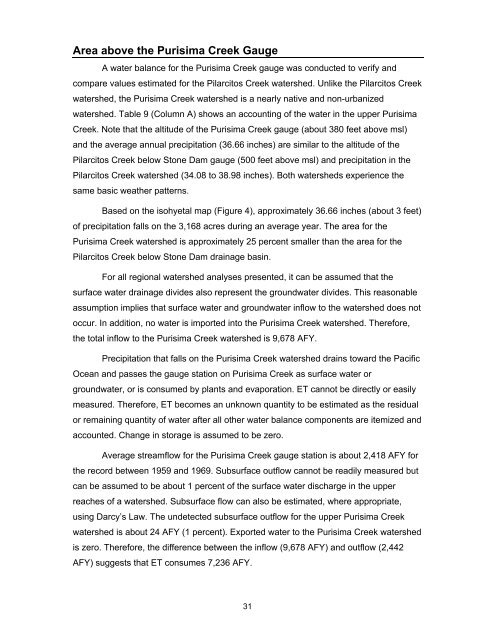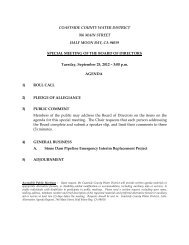Lower Pilarcitos Creek Groundwater Basin Study - Coastside ...
Lower Pilarcitos Creek Groundwater Basin Study - Coastside ...
Lower Pilarcitos Creek Groundwater Basin Study - Coastside ...
Create successful ePaper yourself
Turn your PDF publications into a flip-book with our unique Google optimized e-Paper software.
Area above the Purisima <strong>Creek</strong> Gauge<br />
A water balance for the Purisima <strong>Creek</strong> gauge was conducted to verify and<br />
compare values estimated for the <strong>Pilarcitos</strong> <strong>Creek</strong> watershed. Unlike the <strong>Pilarcitos</strong> <strong>Creek</strong><br />
watershed, the Purisima <strong>Creek</strong> watershed is a nearly native and non-urbanized<br />
watershed. Table 9 (Column A) shows an accounting of the water in the upper Purisima<br />
<strong>Creek</strong>. Note that the altitude of the Purisima <strong>Creek</strong> gauge (about 380 feet above msl)<br />
and the average annual precipitation (36.66 inches) are similar to the altitude of the<br />
<strong>Pilarcitos</strong> <strong>Creek</strong> below Stone Dam gauge (500 feet above msl) and precipitation in the<br />
<strong>Pilarcitos</strong> <strong>Creek</strong> watershed (34.08 to 38.98 inches). Both watersheds experience the<br />
same basic weather patterns.<br />
Based on the isohyetal map (Figure 4), approximately 36.66 inches (about 3 feet)<br />
of precipitation falls on the 3,168 acres during an average year. The area for the<br />
Purisima <strong>Creek</strong> watershed is approximately 25 percent smaller than the area for the<br />
<strong>Pilarcitos</strong> <strong>Creek</strong> below Stone Dam drainage basin.<br />
For all regional watershed analyses presented, it can be assumed that the<br />
surface water drainage divides also represent the groundwater divides. This reasonable<br />
assumption implies that surface water and groundwater inflow to the watershed does not<br />
occur. In addition, no water is imported into the Purisima <strong>Creek</strong> watershed. Therefore,<br />
the total inflow to the Purisima <strong>Creek</strong> watershed is 9,678 AFY.<br />
Precipitation that falls on the Purisima <strong>Creek</strong> watershed drains toward the Pacific<br />
Ocean and passes the gauge station on Purisima <strong>Creek</strong> as surface water or<br />
groundwater, or is consumed by plants and evaporation. ET cannot be directly or easily<br />
measured. Therefore, ET becomes an unknown quantity to be estimated as the residual<br />
or remaining quantity of water after all other water balance components are itemized and<br />
accounted. Change in storage is assumed to be zero.<br />
Average streamflow for the Purisima <strong>Creek</strong> gauge station is about 2,418 AFY for<br />
the record between 1959 and 1969. Subsurface outflow cannot be readily measured but<br />
can be assumed to be about 1 percent of the surface water discharge in the upper<br />
reaches of a watershed. Subsurface flow can also be estimated, where appropriate,<br />
using Darcy’s Law. The undetected subsurface outflow for the upper Purisima <strong>Creek</strong><br />
watershed is about 24 AFY (1 percent). Exported water to the Purisima <strong>Creek</strong> watershed<br />
is zero. Therefore, the difference between the inflow (9,678 AFY) and outflow (2,442<br />
AFY) suggests that ET consumes 7,236 AFY.<br />
31



